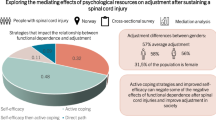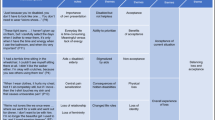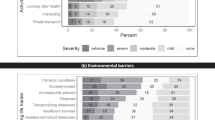Abstract
Study design:
Cross-sectional survey.
Objectives:
To describe coping strategy use in adolescents with spinal cord injury (SCI), to explore the underlying factor structure of a measure of coping among adolescents with SCI and to assess relationships between coping and psychosocial outcomes. Setting: Multiple pediatric SCI centers in the United States.
Methods:
One hundred and eighty-two participants aged 13–17 years who experienced an SCI completed measures including the Kidcope, Children’s Depression Inventory, Revised Children’s Manifest Anxiety Scale and the Pediatric Quality of Life Inventory.
Results:
Participants reported that cognitive restructuring and resignation are the most used coping strategies, whereas social support, emotional regulation (calming) and cognitive restructuring are the most effective coping strategies. An exploratory factor analysis revealed that a three-factor solution provided the most parsimonious model for the relationships between the different coping strategies. However, only one of the three factors had acceptable internal consistency. This factor comprised escape-oriented coping strategies or an avoidant approach to coping with the sequelae of SCI. After controlling for demographic/injury-related factors, higher scores on the escape-oriented factor were associated with the lower quality of life and higher levels of depression and anxiety symptomatology.
Conclusion:
Escape-oriented coping is associated with maladaptive psychosocial outcomes in adolescents with SCI. These adolescents report that active coping strategies are most effective in reducing SCI-related distress. Coping strategy use may mediate psychosocial outcomes in adolescents with SCI and represent an intervention target in adolescents who overly rely on escape-oriented coping.
Similar content being viewed by others
Log in or create a free account to read this content
Gain free access to this article, as well as selected content from this journal and more on nature.com
or
References
Spirito A . Commentary: Pitfalls in the use of brief screening measures of coping. J Pediatr Psychol 1996; 21: 573–575.
Lazarus RS, Folkman S . Stress, Appraisal, and Coping. Springer Publishing Company: New York, p 141, 1984.
Skinner EA, Zimmer-Gembeck MJ . The development of coping. Annu Rev Psychol 2007; 58: 119–144.
Spirito A, Stark LJ, Gil KM, Tyc VL . Coping with everyday and disease-related stressors by chronically ill children and adolescents. J Am Acad Child Psy 1995; 34: 283–290.
Holen S, Lervåg A, Waaktaar T,, Ystgaard M . Exploring the associations between coping patterns for everyday stressors and mental health in young schoolchildren. J School Psychol 2011; 50: 167–193.
Cheng ST, Chan ACM . Factorial structure of the Kidcope in Hong Kong adolescents. J Genet Psychol 2003; 164: 261–266.
Anderson CJ, Vogel LC, Chlan KM, Betz RR . Coping with spinal cord injury: strategies used by adults who sustained their injuries as children or adolescents. J Spinal Cord Med 2008; 31: 290.
Buunk AP, Zurriaga R, González P . Social comparison, coping and depression in people with spinal cord injury. Psychol Health 2006; 21: 791–807.
Aldwin CM . Stress, Coping, and Development: An Integrative Perspective. Guilford Press. 2007.
American Spinal Injury Association. International Standards for the Neurological Classification of Spinal Cord Injury. American Spinal Cord Injury Association: Chicago, IL. 2003.
Spirito A, Stark LJ, Williams C . Development of a brief coping checklist for use with pediatric populations. J Pediatr Psychol 1988; 13: 555–574.
Kovacs M,, Staff M . Children's Depression Inventory (CDI): Technical Manual Update. Multi-Health Systems. Inc: North Tonawanda. 2003.
Reynolds CR, Richmond BO . Revised Children’s Manifest Anxiety Scale (RCMAS): Manual. Western Psychological Services: Los Angeles. 2000.
Varni JW, Seid M,, Kurtin PS . PedsQL (TM) 4.0: Reliability and validity of the Pediatric Quality of Life Inventory (TM) version 4.0 Generic Core Scales in healthy and patient populations. Med Care 2001; 39: 800–812.
Muthén LK, Muthén BO . Mplus User's Guide 5th edn. 1998–2007.
Anderson CJ, Kelly EH, Klaas SJ, Russell HF, Darharsh E, Vogel LC . Anxiety and depression in children and adolescents with spinal cord injuries. Dev Med Child Neurol 2009; 51: 826–832.
Augutis M, Anderson C . Coping strategies recalled by young adults who sustained a spinal cord injury during adolescence. Spinal Cord 2011; 50: 213–219.
Krause JS, Saunders LL, Newman S . Posttraumatic stress disorder and spinal cord injury. Arch Phys Med Rehab 2010; 91: 1182–1187.
Fledderus M, Bohlmeijer ET, Pieterse ME . Does experiential avoidance mediate the effects of maladaptive coping styles on psychopathology and mental health? Behav Modif 2010; 34: 503–519.
Acknowledgements
We acknowledge the adolescents, caregivers and staff who contributed to this research and Shriners Hospitals for Children (Grant #9143) for funding this project.
Author information
Authors and Affiliations
Corresponding author
Ethics declarations
Competing interests
The authors declare no conflict of interest.
Rights and permissions
About this article
Cite this article
Smith, T., Russell, H., Kelly, E. et al. Examination and measurement of coping among adolescents with spinal cord injury. Spinal Cord 51, 710–714 (2013). https://doi.org/10.1038/sc.2013.65
Received:
Revised:
Accepted:
Published:
Issue date:
DOI: https://doi.org/10.1038/sc.2013.65
Keywords
This article is cited by
-
Exploring narratives of resilience among seven males living with spinal cord injury: a qualitative study
BMC Psychology (2018)
-
Pediatric Spinal Cord Injury
Current Physical Medicine and Rehabilitation Reports (2014)



